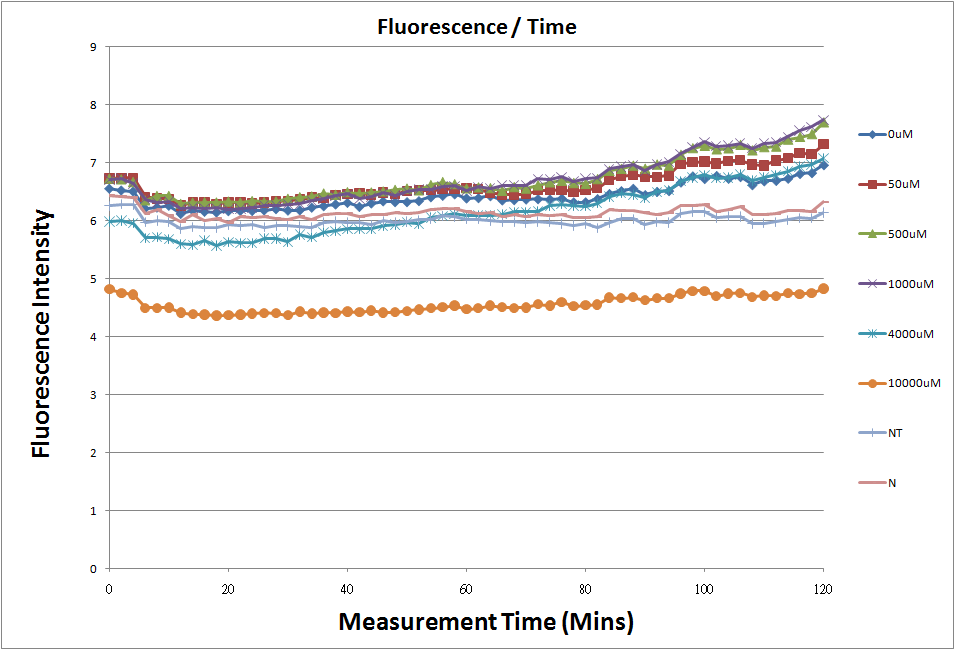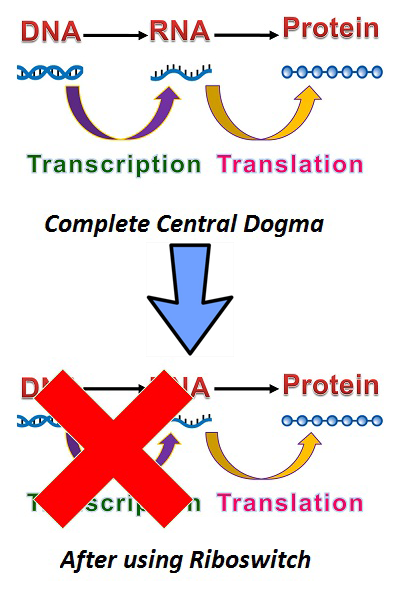Team:NYMU-Taipei/Project/Speedy switch
From 2010.igem.org
| Home | Project Overview | Speedy reporter | Speedy switch | Speedy protein degrader | Experiments and Parts | Applications | F.A.Q | About Us |
Contents |
Abstract
- In our project, speedy switch controls the "on/off" of RNA translation. We use "Riboswitch" as our speedy switch to pause central dogma at mRNA level.
In the past, translating proteins from DNA has followed the central dogma of molecular biology: DNA to RNA to Protein. Normally, after mRNA is transcribed from DNA, ribosomes will bind to the ribosome binding site(RBS) and begin translating mRNA into protein. During this process, we have no way of knowing the location, nor the quantity of mRNA; and after the process, mRNA is quickly degraded. As such, it is very hard to research the detailed roles and implications of mRNA in the central dogma. To resolve this problem, we placed a mRNA level based switch which can be used to control the translation of mRNA: riboswitch
Speedy Switch Device
- Function of Speedy Switch: speed up the cycle from DNA to mRNA to protein and act as a switch between the mRNA and protein levels
In our project, Speedy Switch serves two main roles. The first is to speed up the cycle from DNA to mRNA to protein. Using a riboswitch we can pretranscribe a DNA into an mRNA, ready to be translated at a moments notice. In essence, we can create protein without having to wait for transcription. The second role the riboswitch serves is to act as a switch between the mRNA and protein levels. Using a riboswitch, we can control the expression of proteins downstream.
Typically, since translation often occurs the moment mRNA passed into the cytoplasm, protein and mRNA normally exist together. With a riboswitch control, we can study both the expression of mRNA and the expression of protein in the same cells, without the added implication of protein-mRNA interference.
Purpose
- Verification of protein function: we can perform RNA assay & protein assay in the same cell
- Control of protein expression
Introduction
- In this device, we use "Riboswitch" as our speedy switch. Riboswitch is able to control the translation. It is divided into two parts: a sensor and an actuator.
Before the discovery of RNA regulatory system , the only way to induce reaction in a cell was through inducible promoters. By turning these promoters on or off, we could control the transcription of the downstream DNA into RNA thus also controlling the translation of RNA to Protein. However, with only promoters we traditionally skip the RNA system involved in the pathway of protein synthesis. By inserting a "switch" between the DNA and RNA system we can make a thorough inspection into the individual mechanism of both systems and the cross-effect between their regulatory factors.
The discovery of the riboswitch was based on data which described conserved mRNA secondary structure found on 5’-untranslated regions and the creation of small-molecule binding mRNA, sensors. The function of these riboswitches is similar to the function of inducible promoters in that they both regulate downstream genetic data: their difference is that while promoters regulate transcription of DNA, riboswitches control translation of mRNA.
A riboswitch is a part of mRNA molecule that can bind a small molecule. When it does, the riboswitch will change its structure to regulate the following gene's activity.
A riboswitch have two parts: a sensor and an actuator. These two components work together to form a ‘switch’. The sensor binds to a small molecule inducer, and the actuator structurally changes to regulate gene expression. (Harbaugh et al.,2008)(Lynch et al., 2006)
Experiment
Design
In order for a suitable riboswitch to work in our experiment, it needs to have the following characteristics:
- The inducer does not naturally exist or metabolize in the target organism.
- The riboswitch does not exist naturally in the target organism.
- The riboswitch does not have EcoRI, XbaI, SpeI, or PstI cutting sites.
- Although we can modify the cutting sites of our riboswitch, this action may cause more problems: the cutting site may mutate the secondary structure and molecule binding sites causing it to cease function.
Example of speedy switch
Because we use Escherichia coli DH5&alpha as our organism, so we found that the Theophylline Riboswitch fits all the requirements.
Since most riboswitches already have a Ribosome binding site (RBS) in its structure, we did not add another RBS in front of downstream reporter.
Transform the whole structure,"promoter+ riboswitch+ GFP+ terminator in plasmid" to Escherichia coli. It will express GFP when theophylline (the inducer) is introduced.
To test our hyposthesis, we needed to construct a circuit that has a promoter, a riboswitch, a reporter, and a terminator. We chose to use the theophylline riboswitch as it suited our requirements.
When the full sequence outlined above is transformed into the bacteria, it waits, inactivated, for the right small molecule inducer, in this case, theophylline. When theophylline is added, it will induce the riboswitch to fold differently to allow the translation of the downstream gene, without waiting for transcription.
By comparing the flourescence intensity data (the speed of GFP production), we can determine the difference in time between the traditional method of inducing promoters, to our method of inducing mRNA.
Composition of our circuit
Promoter
- We use pLac this constitutive promoter in biobrick [http://partsregistry.org/Part:BBa_R0010 BBa_R0010]
We use the constitutive promoter because it can keeping working without additional stimulation. So we can get sufficient mRNA with Theophylline Riboswitch in Escherichia coli DH5&alpha. We just add Theophylline and Theophylline Riboswitch will function rapidly.
Theophylline Riboswitch
Since the sequence length of this riboswitch is relatively short, we decided to synthesize the riboswitch directly using two primers (which also contain the biobrick prefix and suffix):
- sequence
ggtgataccagcatcgtcttgatgcccttggcagcaccccgctgcaagacaacaag forward primer : gaattcgcggccgcttctagag ggtgataccagcatcgtcttgatgcccttggcag reverse primer : ctgcagcggccgctactagtacttgttgtcttgcagcggggtgctgccaagggcatcaagac
PCR expected result (99bp)
gaattcgcggccgcttctagagggtgataccagcatcgtcttgatgcccttggcag
gaattcgcggccgcttctagagggtgataccagcatcgtcttgatgcccttggcagcaccccgctgcaagacaacaagtactagtagcggccgctgcag
gtcttgatgcccttggcagcaccccgctgcaagacaacaagtactagtagcggccgctgcag
These two primers anneal at this common region.
GFP+terminator
- We use biobrick [http://partsregistry.org/Part:BBa_J04630 BBa_J04630]
We used Green fluorescent protein as our reporter for two main reasons. First, GFP makes a great reporter because it fluoresces when it is activated, making itself easy to detect. We can measure the activity of the promoter by the intensity of the fluorescence . The second reason is that the GFP used is a biobrick, thus if another team needed to use this riboswitch circuit, it would be easy for them to attach another biobrick. So we chose biobrick - [http://partsregistry.org/Part:BBa_J04630 BBa_J04630] (GFP with terminator)
Whole Process
- First, two riboswitch primer will anneal together at common region by real PCR.
- We then digested the riboswitch PCR product and a plasmid containing the plasmid backbone pSB1A2 with the restriction enzymes XbaI and PstI.
- After gel extraction/PCR purification of the relevant parts, we ligated them and produced the biobrick part [http://partsregistry.org/Part:BBa_K411101 BBa_K411101].
- Performed a back insert of [http://partsregistry.org/Part:BBa_J04630 BBa_J04630(GFP+terminator)] (digested with XbaI and PstI) into [http://partsregistry.org/Part:BBa_K411101 BBa_K411101] (digested with SpeI and PstI) and formed the biobrick [http://partsregistry.org/Part:BBa_K411102 BBa_K411102].
- Performed another back insert of [http://partsregistry.org/Part:BBa_K411102 BBa_K411102] (digested with XbaI and PstI) into [http://partsregistry.org/Part:BBa_R0010 BBa_R0010(lac promoter)] (digested with SpeI and PstI) and formed the biobrick [http://partsregistry.org/Part:BBa_K411103 BBa_K411103].
- Finally we tested this kind of E. coli. We add Theophylline to induce riboswitch and and translate GFP.
Result
In theory, if we add more inducer into cell, riboswitch will translate more GFP. But theophylline is toxic for Escherichia coli. From paper, we know that if theophylline concentration is over 5 μM, Escherichia coli will die.[Lynch06]

In this picture, it proved that our switch can really work. The more theophylline we add, more GFP will express. For more speedy switch experimental data, please check out our SpeedBac experimental result.
Reference
- [Desai04]Shawn K. Desai and Justin P. Gallivan(2004)Genetic Screens and Selections for Small Molecules Based on a Synthetic Riboswitch That Activates Protein Translation. JASC,VOL. 126
- [Harbaugh08] Svetlana V. Harbaugh, Molly E. Davidson, Yaroslav G. Chushak, Nancy Kelley-Loughnane, and Morley O. Stone(2008) Riboswitch-based sensor in low optical background. Proc. of SPIE Vol. 7040
- [Lynch06] Sean A. Lynch, Shawn K. Desai, Hari Krishna Sajja, and Justin P. Gallivan1 (2006). A High-Throughput Screen for Synthetic Riboswitches Reveals Mechanistic Insights into Their Function. CELL DOI 10.1016/j.chembiol.
- [Topp07] Shana Topp and Justin P. Gallivan(2007)Guiding Bacteria with Small Molecules and RNA. JACS, VOL. 129
- [Mandal03] Maumita Mandal, Benjamin Boese,Jeffrey E. Barrick, Wade C. Winkler, and Ronald R. Breaker1(2003). Riboswitches Control Fundamental Biochemical Pathways in Bacillus subtilis and Other Bacteria. Cell, Vol. 113, 577–586
- [Suess04]Beatrix Suess, Barbara Fink, Christian Berens, ReÂgis Stentz and Wolfgang Hillen(2004)A theophylline responsive riboswitch based on helix slipping controls gene expression in vivo. Nucleic Acids Research, Vol. 32, No. 4
 "
"



